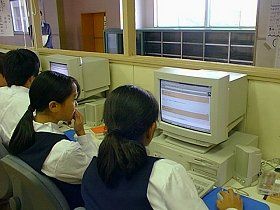 To teach students
how to use the Internet as a tool to solve problems, we need to offer well-planned
lessons on a regular basis. Students also need to learn netiquette—proper
rules and manners for using the Internet—and how to collect and publish
information effectively. There was no course that taught such material, so
we began offering a unit called "basic information" in our technical
arts and home economics classes, taught intermittently to each grade throughout
the year, for a total of ten hours. In each grade, students learn the following
step-by-step:
To teach students
how to use the Internet as a tool to solve problems, we need to offer well-planned
lessons on a regular basis. Students also need to learn netiquette—proper
rules and manners for using the Internet—and how to collect and publish
information effectively. There was no course that taught such material, so
we began offering a unit called "basic information" in our technical
arts and home economics classes, taught intermittently to each grade throughout
the year, for a total of ten hours. In each grade, students learn the following
step-by-step: Conference to introduce results from the 100-School Networking Project (Phase II)
Conference to introduce results from the 100-School Networking Project (Phase II)